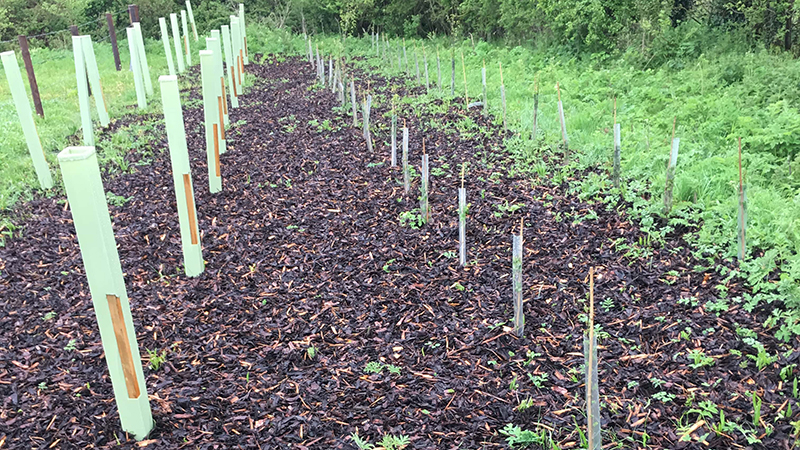Contract Period : 01/11/2021 - 30/04/2024
Main Funder : Dulverton Trust. FiPL (we received a small amount from 2 earlier funds through fwag-sw applications)
ORC Staff Contact : Dr. Lindsay Whistance

The Optimum Shelterbelt project aims to gather knowledge on the benefits of 5-metre-wide shelterbelts in UK farming systems and has just completed the initial establishment and protocol design phase.
The protocols developed by ORC include crop production, animal welfare, microclimate, biomass carbon and biodiversity. We also developed a method for measuring available shelter aimed at simplifying on-farm monitoring for management purposes. Alongside ORC activity, project consortium members will investigate economics and soil carbon changes. It is hoped that participatory research with the consortium landowners will lead to a unique long-term, UK-based study.
The Optimum Shelterbelts project brings together tree suppliers, landowners, wildlife and woodland consultants and researchers to characterise the different impacts of the shelterbelts as they become established. Much research has been done to model the potential benefits from planting trees to form a barrier behind which livestock and crops can be protected from extreme weather including wind, sun and rain. Less research, however, has been done into how this translates into practice, particularly in UK conditions. At the same time, research trials typically focus on single themes, for example, lamb survival or carbon sequestration, whilst here, several themes are being investigated within the same timeframe. Doing this helps our understanding of the impacts of the shelterbelt within and between each theme over time. The OSB project aims to capture and identify these impacts through a participatory approach, allowing for the potential for long-term monitoring as well as developing best practice guidelines for shelterbelt management.
The wider project has also received funding from FWAG, The Woodland Trust, Great Western Community Forest, Cotswold National Landscape, and Protect Earth.
The initial phase of the project is now complete (see below) and fund-raising is in progress to develop activities further.
The OSB Consortium continue to engage with stakeholders on the potential for implementing shelterbelts and their benefits on farms. This includes engaging with policy makers, foresters, advisors and practitioners. The results from establishment and protection trials are being shared across FWAG groups and will be made publicly available once the establishment phase is fully completed.
FWAG-SW – Maisie Jepson
Tree Shop – John Davis
David Lewis – Woodland Management Consultant
The project has a participatory approach to research and ORC’s role has been to develop protocols designed to include a range of approaches tailored to robust data collection and available resources. These approaches include data being variously collected by technology, researcher, farmer and volunteer activity.
This project aims to characterise shelterbelts and their effects through participatory in-field trials, bringing together key stakeholders to establish long-term studies that produce knowledge and support for a wider audience that attempts to classify an optimum shelter belt.
Specifically, the main objectives are:
Read Lindsay Whistance’s blog https://agricology.co.uk/blog/optimum-shelterbelts-right-tree-right-place/
The establishment, protection and maintenance activity of the OSB project continues with FWAG-SW and the Tree Shop fundraising for these activities. For the research element, the next step is to trial each protocol on farm and to identify the modifications and on-farm management required. Further data collection and refinements – subject to procurement of equipment – will help ensure the accuracy and reliability of long-term data collection. The results will be an important resource both for trial farmers and the wider farming community seeking to carry out best practice at both farm and landscape levels to optimise benefits for crops and animals in the farmed landscape and for wider ecological health.
The current funding for ORC’s role in this project came to an end in April 2024, and we are most grateful to the Dulverton Trust for their generous support for the development of protocols for each theme being investigated. The protocols are designed to include a combination of researcher and farmer/volunteer data collection and have been discussed and agreed by consortium members.
A report including the developed protocols has been submitted to the funders. Now that the 22 shelterbelts included in the project are planted, the next phase is to refine and test these protocols in the field with a view to collecting data over the long term.
Optimal Shelterbelts newsletter Q1/2022
Blog by Lower Hampen Farm: https://www.homegrownathampen.co.uk/shelterbelts/
Davis J, Whistance L, Lewis D (2023) The role and benefits of shelterbelts on farms. Quarterly Forest Journal. 117(2): 115-121
The protocols developed during the project feature as appendices to the Final Report or download them individually below: